Top Rankings
San Angelo Independent School District ranks among the top 20% of public school district in Texas for:
Category
Attribute
Community Size
Largest student body (number of students) (Top 1%)
For the 2025 school year, there are 8 public preschools serving 2,984 students in San Angelo Independent School District. This district's average pre testing ranking is 2/10, which is in the bottom 50% of public pre schools in Texas.
Public Preschools in San Angelo Independent School District have an average math proficiency score of 27% (versus the Texas public pre school average of 43%), and reading proficiency score of 40% (versus the 53% statewide average).
Minority enrollment is 77% of the student body (majority Hispanic), which is more than the Texas public preschool average of 76% (majority Hispanic).
Overview
This School District
This State (TX)
# Schools
23 Schools
4,192 Schools
# Students
13,180 Students
2,151,418 Students
# Teachers
855 Teachers
147,942 Teachers
Student : Teacher Ratio
15:1
15:1
District Rank
San Angelo Independent School District, which is ranked #971 of all 1,196 school districts in Texas (based off of combined math and reading proficiency testing data) for the 2021-2022 school year.
The school district's graduation rate of 92% has increased from 88% over five school years.
Overall District Rank
#979 out of 1204 school districts
(Bottom 50%)
(Bottom 50%)
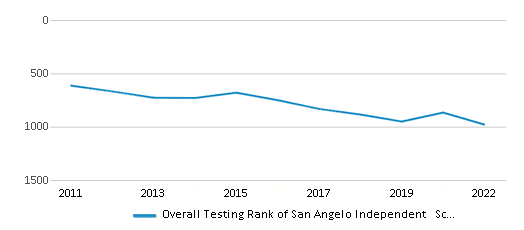
Math Test Scores (% Proficient)
27%
41%

Reading/Language Arts Test Scores (% Proficient)
40%
51%
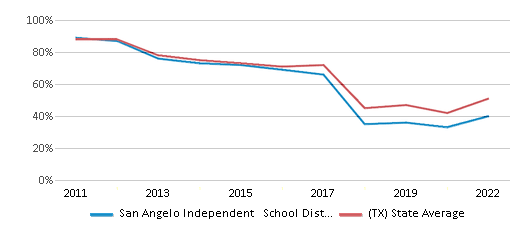
Science Test Scores (% Proficient)
35%
46%
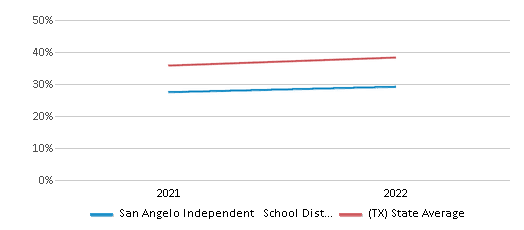
Graduation Rate
92%
90%
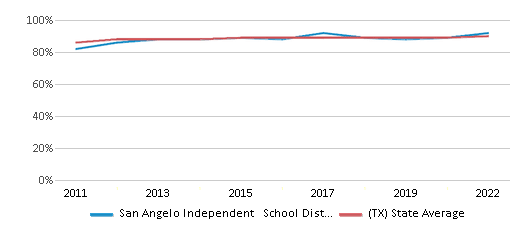
Students by Ethnicity:
Diversity Score
0.53
0.63
# American Indian Students
23 Students
6,302 Students
% American Indian Students
n/a
n/a
# Asian Students
143 Students
104,203 Students
% Asian Students
1%
5%
# Hispanic Students
8,193 Students
1,180,208 Students
% Hispanic Students
62%
55%
# Black Students
431 Students
275,255 Students
% Black Students
4%
13%
# White Students
3,958 Students
509,082 Students
% White Students
30%
24%
# Hawaiian Students
19 Students
3,291 Students
% Hawaiian Students
n/a
n/a
# Two or more races Students
413 Students
73,077 Students
% of Two or more races Students
3%
3%
Students by Grade:
# Students in PK Grade:
393
275,832
# Students in K Grade:
852
307,607
# Students in 1st Grade:
1,002
310,480
# Students in 2nd Grade:
1,010
317,113
# Students in 3rd Grade:
960
300,451
# Students in 4th Grade:
961
295,281
# Students in 5th Grade:
1,053
258,890
# Students in 6th Grade:
930
33,806
# Students in 7th Grade:
940
14,241
# Students in 8th Grade:
972
12,959
# Students in 9th Grade:
1,280
7,002
# Students in 10th Grade:
1,083
6,366
# Students in 11th Grade:
940
5,781
# Students in 12th Grade:
804
5,609
# Ungraded Students:
-
-
District Revenue and Spending
The revenue/student of $11,640 in this school district is less than the state median of $13,387. The school district revenue/student has grown by 6% over four school years.
The school district's spending/student of $10,495 is less than the state median of $14,116. The school district spending/student has grown by 6% over four school years.
Total Revenue
$153 MM
$74,029 MM
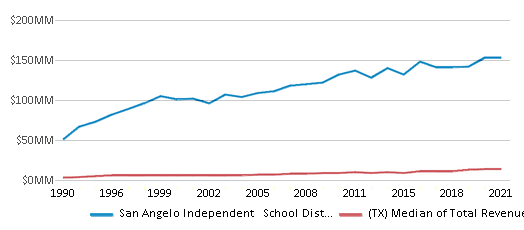
Spending
$138 MM
$78,063 MM
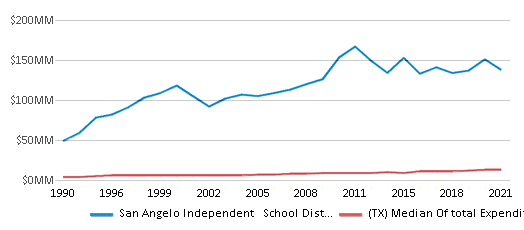
Revenue / Student
$11,640
$13,387
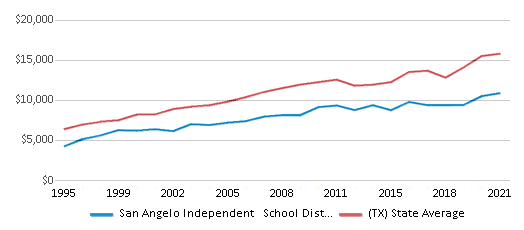
Spending / Student
$10,495
$14,116
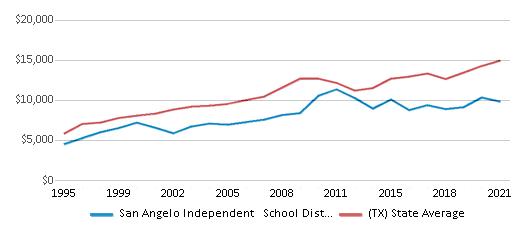
Best San Angelo Independent School District Public Preschools (2025)
School
(Math and Reading Proficiency)
(Math and Reading Proficiency)
Location
Grades
Students
Rank: #11.
Glenmore Elementary School
(Math: 44% | Reading: 59%)
Rank:
Rank:
7/
Top 50%10
323 Penrose St
San Angelo, TX 76903
(325) 659-3657
San Angelo, TX 76903
(325) 659-3657
Grades: PK-5
| 449 students
Rank: #22.
Reagan Elementary School
(Math: 35-39% | Reading: 45-49%)
Rank:
Rank:
5/
Bottom 50%10
1600 Volney St
San Angelo, TX 76903
(325) 659-3666
San Angelo, TX 76903
(325) 659-3666
Grades: PK-5
| 257 students
Rank: #33.
Crockett Elementary School
(Math: 30-34% | Reading: 40-44%)
Rank:
Rank:
4/
Bottom 50%10
2104 Johnson Ave
San Angelo, TX 76904
(325) 947-3925
San Angelo, TX 76904
(325) 947-3925
Grades: PK-5
| 366 students
Rank: #44.
Belaire Elementary School
(Math: 20-24% | Reading: 45-49%)
Rank:
Rank:
3/
Bottom 50%10
700 Stephens St
San Angelo, TX 76905
(325) 659-3639
San Angelo, TX 76905
(325) 659-3639
Grades: PK-5
| 317 students
Rank: #55.
Goliad Elementary School
(Math: 27% | Reading: 41%)
Rank:
Rank:
3/
Bottom 50%10
120 E 39th St
San Angelo, TX 76903
(325) 659-3660
San Angelo, TX 76903
(325) 659-3660
Grades: PK-5
| 523 students
Rank: #66.
Holiman Elementary School
(Math: 25-29% | Reading: 30-34%)
Rank:
Rank:
2/
Bottom 50%10
1900 Ricks Dr
San Angelo, TX 76905
(325) 659-3663
San Angelo, TX 76905
(325) 659-3663
Grades: PK-5
| 324 students
Rank: #77.
San Jacinto Elementary School
(Math: 20-24% | Reading: 30-34%)
Rank:
Rank:
2/
Bottom 50%10
800 Spaulding St
San Angelo, TX 76903
(325) 659-3675
San Angelo, TX 76903
(325) 659-3675
Grades: PK-5
| 317 students
Rank: #88.
Bradford Elementary School
(Math: 6-9% | Reading: 15-19%)
Rank:
Rank:
1/
Bottom 50%10
2302 Bradford St
San Angelo, TX 76903
(325) 659-3645
San Angelo, TX 76903
(325) 659-3645
Grades: PK-5
| 431 students
Recent Articles

What Is A Charter School?
Explore the world of charter schools in this comprehensive guide. Learn about their history, how they operate, and the pros and cons of this educational innovation. Discover key facts about charter schools, including admission policies, demographics, and funding, as well as what to look for when considering a charter school for your child.

10 Reasons Why High School Sports Benefit Students
Discover the 10 compelling reasons why high school sports are beneficial for students. This comprehensive article explores how athletics enhance academic performance, foster personal growth, and develop crucial life skills. From improved fitness and time management to leadership development and community representation, learn why participating in high school sports can be a game-changer for students' overall success and well-being.

February 05, 2025
Understanding the U.S. Department of Education: Structure, Impact, and EvolutionWe explore how the Department of Education shapes American education, from its cabinet-level leadership to its impact on millions of students, written for general audiences seeking clarity on this vital institution.





